|
Schweinfurt, Part
7
German Military in
Schweinfurt - Barracks and Panzer Regiments 4 and 36
Starting in 1936 the
German Wehrmacht had a large presence in Schweinfurt, with three military
barracks. The Adolf-Hitler-Kaserne, commonly called the Panzerkaserne, was built
on the western edge of the city in 1936 for Panzer Regiment 4. Panzer Regiment 4
was an armor unit armed with the PanzerKampfwagen I tank, the first of a long
line of German tank development which culminated in the famous Tiger tank.
Panzer Regiment 4 officially arrived in the city in a grand parade through the
downtown area to its new barracks on Niederwerrnerstraße (the Panzer Kaserne). Click
here to go directly to the section on military barracks
(below).

|

|
The
Pzkw. I tanks of Panzer Regiment 4 parading through the Marktplatz upon
their arrival in the city, 6 October 1936. Below, a command tank leads a column
of motorized troops. A Panzer regiment in 1936 was a combined-arms unit,
including tanks, motorized infantry, and light artillery and anti-tank
guns. (Stadtarchiv Schweinfurt) |
 |
 |

|

|
The
regimental staff had two command variants of the PzKw. I tank. These
command tanks had no turret and lacked the machine guns of the basic
tanks, and they also had a longer hull with a higher powered engine.
Above, presumably the regimental commander Oberst (Colonel) Kühn with a bouquet of
flowers. Below, the command tanks are parked in front of the Adler
Apotheke (Eagle Pharmacy), the lighter building in the center of the
photo. The Adler Apotheke still occupies the same location today. (Stadtarchiv
Schweinfurt) |
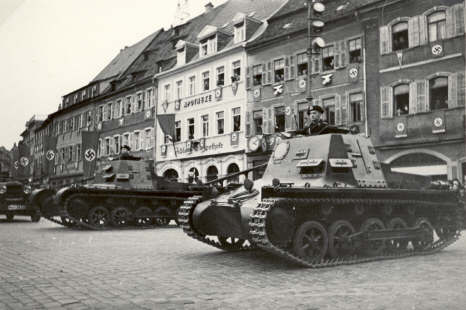 |
 |

|
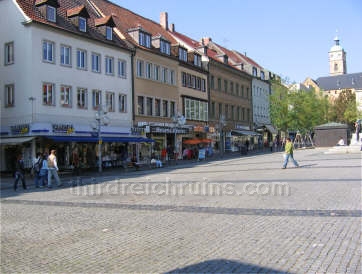
|
These
photos demonstrate the basic differences between the PzKw. I command tanks
and the earlier version of the tank. Below, the command tanks (Befehlswagen)
are parked in front of the basic tanks. These tanks, armed with two 7.92mm
machine guns in their turrets, were the early Ausf. A version, with four
roadwheels. The later Ausf. B version, like the command tanks, had an
elongated hull with five roadwheels. (Stadtarchiv Schweinfurt) |
 |
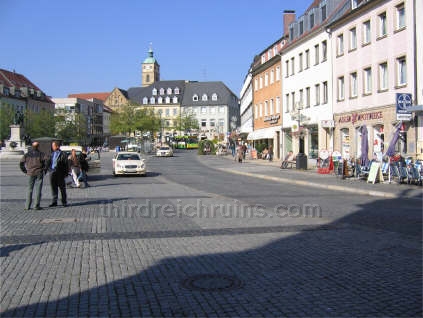 |
-
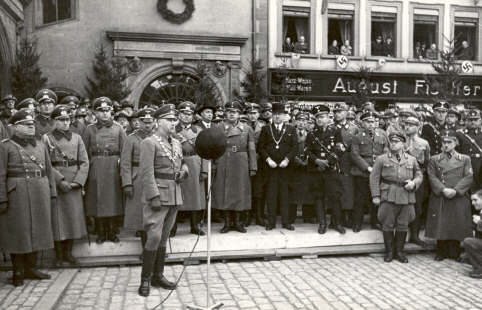
|
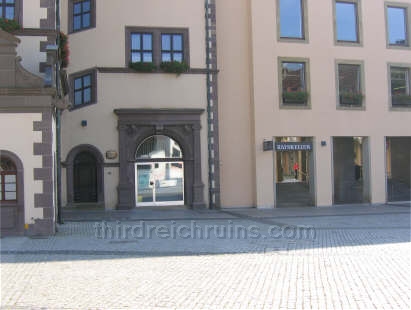
|
Panzer
Regiment 4 was welcomed to Schweinfurt by the city's Nazi leaders,
including Oberbürgermeister (Lord Mayor) Ludwig Pösl, seen above
speaking in front of the Rathaus (city hall). Below, Generalmajor
Heinz Guderian, commander of the German armored forces, shakes Pösl's hand in front of the Rathaus.
Pösl is wearing a black band
over his swastika armband, perhaps a mourning band for someone who had
died. Contrast the view below with a similar
view of the damage from the 17 August 1943 bombing. (Stadtarchiv
Schweinfurt) |
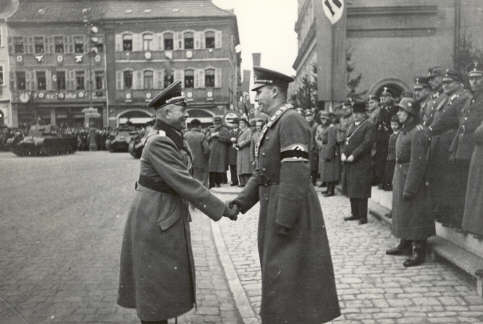 |
 |
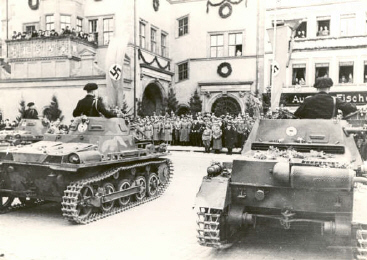 |
 |
| The new Pzkw. I tanks of
Panzer Regiment 4 parked in
the Marktplatz, facing the Rathaus and the gathered dignitaries (the vehicle on the right is
the command
variant). (Stadtarchiv Schweinfurt) |
 |
 |
| At the
conclusion of the ceremonies on the Marktplatz, the tanks paraded down
Adolf-Hitler-Straße (now Spitalstraße), through the Albrecht-Dürer-Platz, and down
Schultesstraße, on their way to the Panzer Kaserne. The buildings along
Schultesstraße were badly damaged by the wartime bombing attacks, and
most were rebuilt in a more modern style. The key to identifying this
location is the wall of the old city cemetery, seen at the right of both
photos below. The regiment's band can be seen standing on the wall in
the period photo below. (Stadtarchiv Schweinfurt) |
 |
 |
 |
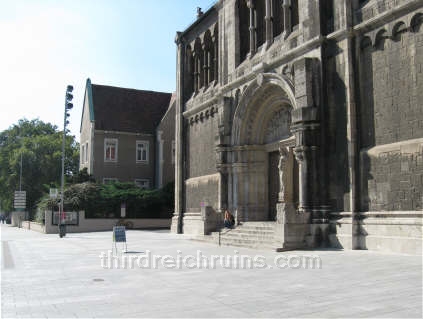 |
| Across Schultesstraße
from the old cemetery is the Heilig-Geist-Kirche
(Church of the Holy Spirit). The dignitaries, including Oberbürgermeister
Pösl and Generalmajor Guderian, stood in front of the church to
review Panzer Regiment 4. (Stadtarchiv Schweinfurt) |

After Panzer Regiment 4 settled into
their new quarters at the Panzer Kaserne, they started a regimen of training
in the local forests north of the city, which became a military training area
(still used by the U.S. Army today).
Here, the crew of a PzKw. I Befehlswagen (command tank) pose during
maneuvers. (author's collection)

Soldiers of Panzer Regiment 4 in
Schweinfurt. (author's collection)

Although Panzer Regiment 4 left
Schweinfurt in 1938 to be stationed in Austria, and was
constantly at the front with the 2nd Panzer Division from the beginning of World
War II,
Schweinfurt was always its "home." The regiment's veterans placed a Gedenkstein
(memorial stone) in the old city cemetery in Schweinfurt.
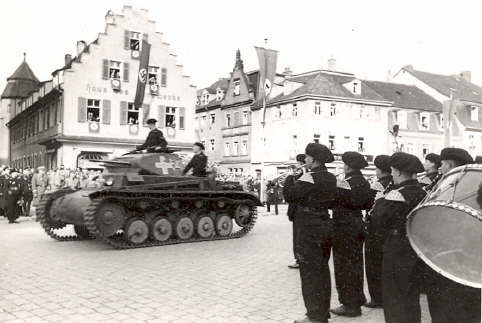 |
 |
| Panzer
Regiment 4 was replaced in Schweinfurt by Panzer Regiment 36. Following
the invasion of Poland, Panzer Regiment 36 returned to a victory parade
in Schweinfurt in October 1939. In the photos above, Pzkw. II and Pzkw.
IV tanks of Panzer Regiment 36 parade along
Schultesstraße as the regimental band plays in front of the old city cemetery.
The distinctive Haus des Handwerks building across the street was
unfortunately destroyed during the war. (Stadtarchiv
Schweinfurt, private collection) |
 |

|

|
Looking
across Schultesstraße from the other side, a Pzkw.
II tank of Panzer Regiment 36 passes in review during the October 1939
victory parade. The crosses on the tank turrets and hulls were used as
recognition symbols during the invasion of Poland. The regimental band in the right
background is playing in front of the Schweinfurt Kriegerdenkmal
(military monument). (Stadtarchiv Schweinfurt) |

|

|
The
Schweinfurt Kriegerdenkmal (military monument) used to stand at the head of the steps leading into the old city
cemetery. The monument was built in 1895 by Ignaz Taschner, but the bronze
figure fell victim to a scrap metal drive during World War II and the base
was removed as well. The flanking stone lions (also by Taschner) were
returned to their guard positions on the entry wall during a cemetery
restoration in 2011. (1915 postcard) |

|
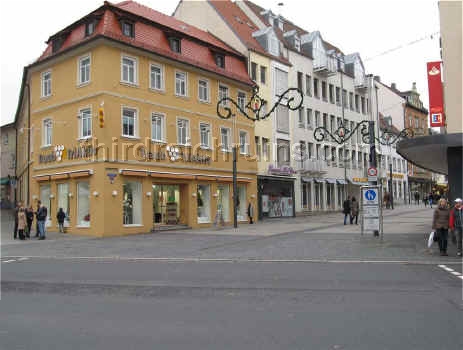
|
During
the October 1939 victory festivities the commander of Panzer Regiment 36, Oberst
(Colonel) Hermann Breith, was photographed walking with Schweinfurt Oberbürgermeister (Lord Mayor) Ludwig
Pösl. The group was walking from the Marktplatz down Adolf-Hitler-Straße
(now Spitalstraße), and had just reached the Albrecht-Dürer-Platz,
walking toward Schultesstraße. During World War II, Breith was to rise to
the rank of General der Panzertruppe and command of the 3rd Panzerkorps,
and was awarded the Knight's Cross with Oak Leaves and Swords. (private
collection) |

|
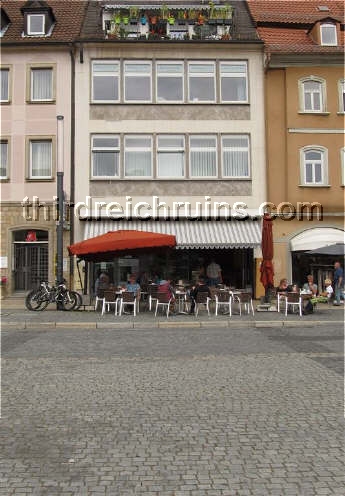
|
Above, officers from Panzer Regiment
36 at a formation in the Marktplatz in December 1940. Below, Pzkw. IV tanks of Panzer Regiment 36 return from the campaign in
France in the summer of 1940. (private
collection) |
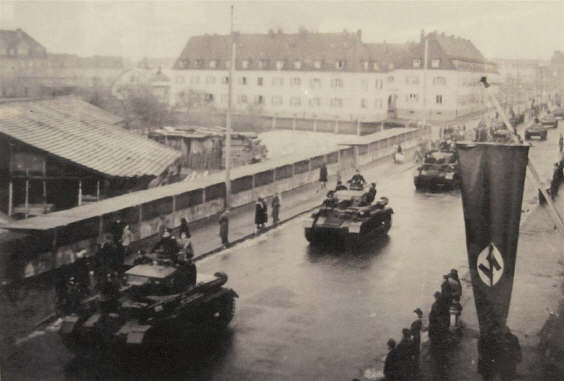 |
Schweinfurt
Military Barracks
The official name of
the post built for Panzer Regiment 4 in 1935-36 was the Adolf-Hitler-Kaserne, but it was more usually
called simply the Panzer Kaserne. The post was taken over by the U.S. Army
in 1945 and was used as Ledward
Barracks until it was closed in September 2014. This was the largest of three Wehrmacht posts built in
Schweinfurt. 2018 Update -
The original buildings of the Panzer Kaserne are being demolished to make way
for a school complex. The two buildings seen directly below MAY be saved.

|

|

|
The regiment's name appears on the right gate post in the period
photos above and below; the eagle on the building is still there today (minus its original
swastika, and the head faces the opposite direction today). Click here to visit Heinz
Leitsch's page on the USAG Schweinfurt (in German - auf Deutsch).
(photos donated) |

|

|
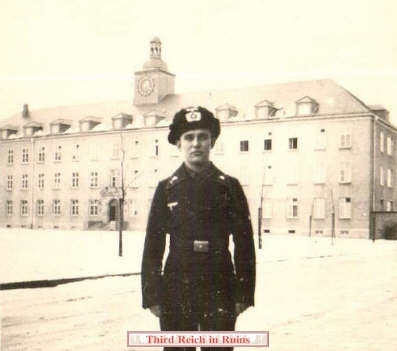 |
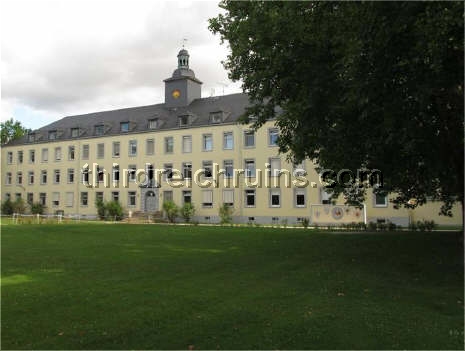 |
| A Panzer
soldier poses in front of the Panzer Kaserne headquarters building. He
is wearing the distinctive early black "Panzer beret," which
was a sort of padded crash helmet designed to provide some protection to
the wearer's head while inside the tank. This somewhat clumsy headgear was replaced in
1941. (author's collection) |

This shield with an eagle and swastika
above a PzKw. I tank can be seen above the main entrance doorway
to the
headquarters building of the Panzerkaserne, in the photo sections above. (courtesy Gerald Stephenson)
Note - the eagle was removed ca. 2010.
|
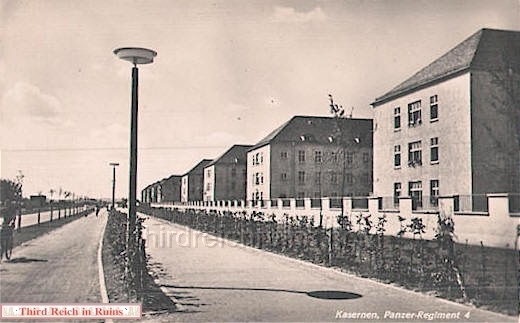
|
|
Above, a 1938 dated postcard
showing the front of the Panzerkaserne, along Niederwerrner Straße.
Below, a similar view from a photo taken in 1942 by a member of
Sturmgeschutz Ersatz Abteilung 200 (Assault Gun Replacement Battalion 200
- one of the training units stationed here). (author's
collection) |
|

|

|
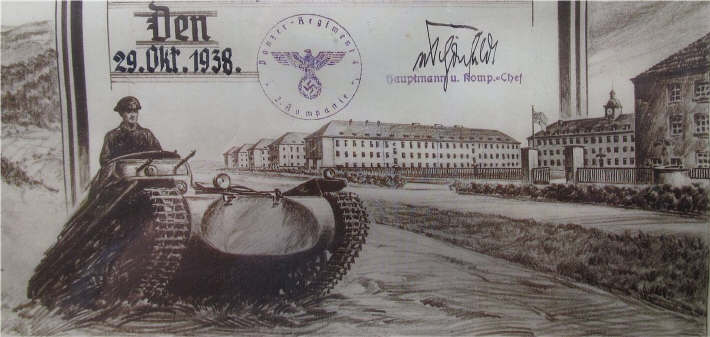
An award document dated 1938 and bearing
the stamp and the company commander's signature of the 2nd Kompanie
of Panzer Regiment 4 featured drawings of the Panzerkaserne and one of the
unit's Pzkw. I tanks.
(courtesy the Deutsch-Amerikanisches Nachkriegsmuseum, Rütschenhausen)
 |
|
The photo above shows one of the main streets on the east side of the Kaserne; for those
familiar with Ledward Barracks, this view shows the end of post with
the Clinic and Bldg.
215. This view is
from a postcard sent home by a soldier in Panzer Ausbildungs Abteilung 25 (one
of the
wartime training units stationed here) - he labeled his barracks building
"Unser Haus". This card was postmarked 16 August 1943, the day
before the first bombing attack on Schweinfurt - during that attack, bombs
would hit the buildings in the foreground of this photo. (author's collection) |
 |
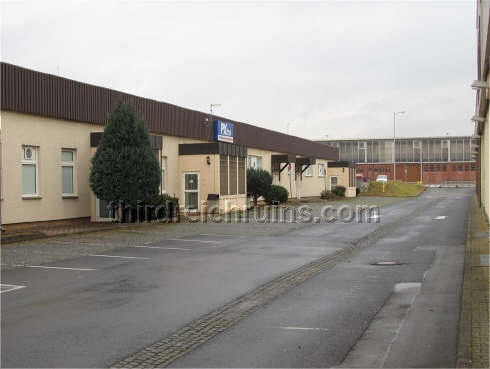 |
| Panzer
crewmen from Panzer Regiment 4 pose in the motor pool area of the Panzer Kaserne, proudly
wearing their tank sharpshooter badges (shoulder cords). They are
standing in front of a new PzKw. II tank - an older PzKw. I tank is in
the background. The nearby motor pool buildings have been remodeled but
the maintenance shop building in the distance remains the same. (These
buildings were torn down in 2017.)
(author's
collection) |
 |
 |
| Above -
Pzkw. I tanks of Panzer Regiment 4 stand ready for inspection in the
motor pool. The motor pool buildings
have changed very little and were still in use until the U.S. Army left
in 2014. (The photo on the
right below is supposed to show Panzer Regiment 4 in 1937, but the doors
on the motor pool bays are different from those at the Schweinfurt
Panzer Kaserne.) (These buildings
were torn down in 2017.) (photos donated; below right - Bundesarchiv) |
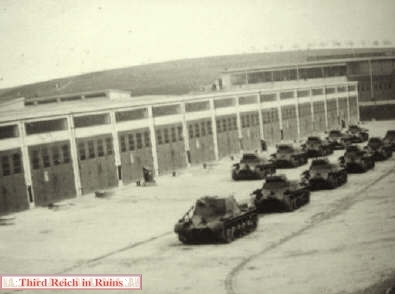 |
 |
 |
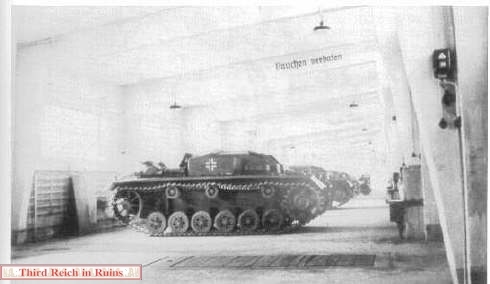 |
| During much of the war, the
Panzer Kaserne was used as a training center for Sturmgeschutz (assault
gun) vehicles. In these 1943 photos, crews are training on chassis with the cannon removed, for driver training.
The Sturmgeschutz
training reached its height in 1944, when some 5000 crewmen were trained
here. The
label on the interior overhead concrete beam reads Rauchen verboten - No
Smoking. (photos donated) |
 |
 |
-
 |
 |
| Unit
standards were dedicated on the Panzer Kaserne parade field on 20
February 1939. Until the post closed in 2014, this area was a parking lot and motor pool.
(These buildings were torn down in
2017.) (photo
donated) |
-
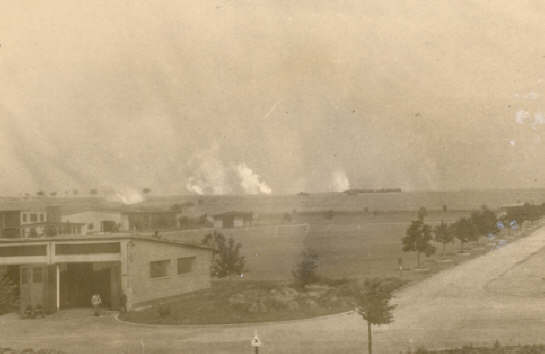
The Großbatterie
Panzerkaserne flak gun emplacement was located on the ridgeline behind
the Panzer Kaserne. This photo shows an exercise of the smoke screen apparatus on
the ridgeline.
The building in the foreground is in one of the motor pools; the buildings seen
in the left background
are the buildings seen in the standard dedication ceremony just above. (Stadtarchiv
Schweinfurt)

This aerial view of the Panzer Kaserne
taken during the bombing attack of 14 October 1943
shows the surrounding area (as well as bomb craters from the earlier attack on
17 August).
1 - Panzer Kaserne parade field, 2 - Panzer Abwehr Kaserne (see below), 3 -
Officers Kasino (see below),
4 - support buildings, 5 - Willy
Sachs Stadium, 6 - two 6-gun positions of the Großbatterie
Panzerkaserne.
(U.S. National
Archives, RG 342FH-3A22426)
 |
 |
 |
 |
| Several
buildings of the former Panzer Kaserne feature period sculpted artwork.
Above, left to right - an ancient Greek warrior, Hercules wrestles a
lion, a medieval knight, a figure that may represent maintenance
personnel; below, left to right - grenadiers with hand grenades,
infantry soldiers, and two figures from the Napoleonic period. All
of these figures were removed from the buildings in 2017, in preparation
to tear the buildings down. The figures were saved, hopefully to be
displayed in an eventual museum in one of the spared buildings. |
 |
 |
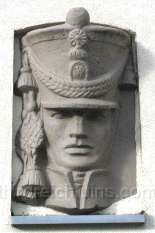 |
 |
 |
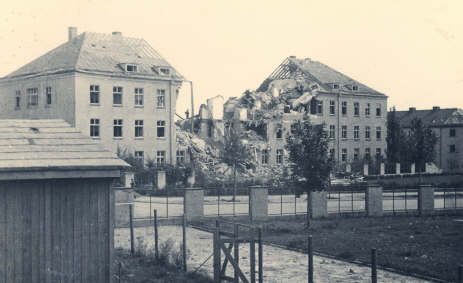 |
| The
Panzer Kaserne was heavily damaged during the bombing attack of 14
October 1943 ("Black Thursday"). These photos show some of the
damaged buildings after the attack. One building was so badly damaged
that it was torn down and never rebuilt (where the Ledward Barracks
Crafts Studio was located). (Stadtarchiv Schweinfurt) |
 |
 |
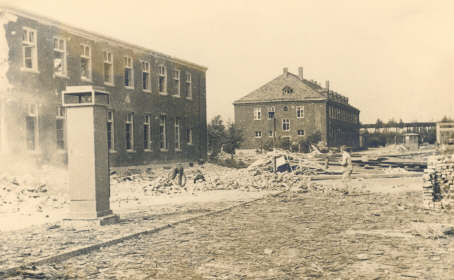 |
 |
 |
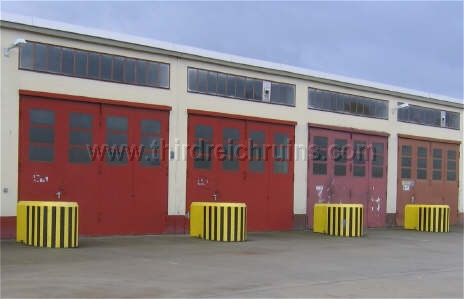 |
| These
photos show damage to the motor pool buildings. The buildings seen at the left below
are those seen in the photos of the standard dedication and smoke screen
above. In the rubble on
the right below was a turret for a Pzkw. 38(t) tank, blown upside-down. (Stadtarchiv
Schweinfurt) |
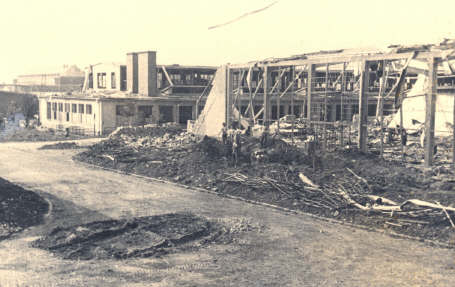 |
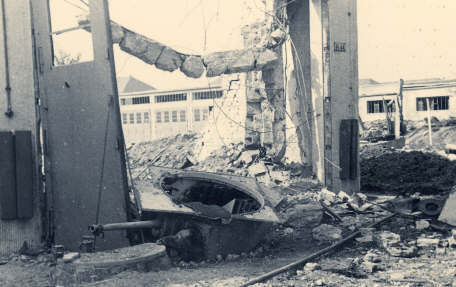 |
-
 |
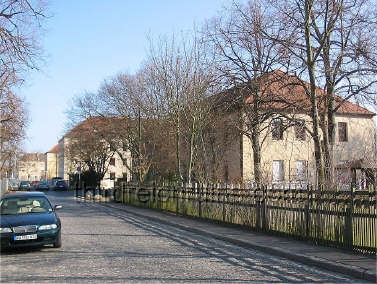 |
| Adjacent
to the Panzer Kaserne, to the east, was the Panzerabwehrkaserne, built in 1936 for Panzerjäger Abteilung 38 (38th Anti-Tank
Battalion). This post was also sometimes called the Hindenburg-Kaserne. These buildings can be seen in the aerial bombing photo
above (labeled #2), across the street from the Panzer Kaserne east gate. Only three of these buildings exist now (the
two furthest buildings and the center building in the period view above), behind the small park across from the Ledward Barracks east
gate. The center building now serves as a Youth Center
(Franz-Josef-Straße 26), and the two other buildings are part of the
Schweinfurt City Services complex. (period postcards) (MapQuest
Map Link) |
 |
 |
 |
 |
| The
period postcard above shows the Panzerabwehrkaserne in 1937. This
monument near the east gate of the former Ledward Barracks honors the dead of Panzerjäger Abteilung 38 (38th Anti-Tank
Battalion), which was stationed at
the Panzerabwehrkaserne and served in the 2nd Panzer Division. (author's
collection) |
 |
 |
| The
barracks Kasino (Officers Club) was located across Niederwerrner
Straße from the Panzer Kaserne. In 1947 it served as the Post Exchange and
Shopping Center for the American military community in the Army of
Occupation (above left). (photo donated) |
-
|

|

|
|
A short distance west of
Schweinfurt was the Flugplatz, a grass airfield that was used to train
pilots for the Ju-87 Stuka dive-bomber (used by the U.S. Army as Conn
Barracks until closed in September 2014). A Luftwaffe eagle is still visible at the main entry
gate. Another reminder of the original owners is a series of woodwork
carvings of curved swastikas, Iron Crosses, eagles, and lions on the
ceiling of one of the Flugplatz buildings. |
|

|
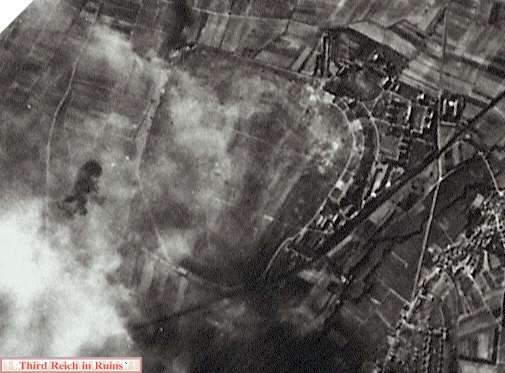
|
|
This view taken during one of
the bombing attacks in February 1944 shows the Schweinfurt Flugplatz,
visible through the smoke near the top of the photo. The close-up shows
the barracks buildings in an arc at the right side, with the open grass
airfield to the left. (U.S.
National
Archives, RG 342FH-3A22448) |
|

|
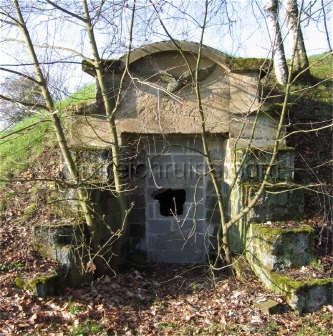
|
|
This underground
structure in the back section of the post is said to have been an air raid shelter,
but it was more likely a munitions storage bunker. This bunker had entrances at both
ends, with right-angle entry into the interior, much like the design of
munitions bunkers at the nearby Rottershausen
flak ammunition storage area. One bunker entrance features a
Luftwaffe eagle over the doorway, while the other has the curious
inscription "Urlaubsbunker." (MapQuest
Map Link) |
 |
 |
|

|

|
|
The
trainee Ju-87 Stuka pilots flew from the Schweinfurt Flugplatz to a small bombing range near
Sulzheim, southeast of Schweinfurt. Here they practiced their
dive-bombing techniques with both live explosive bombs and concrete
practice bombs. The remains of many of these concrete bombs can still be
seen at the site today. (MapQuest
Map Link) |
|
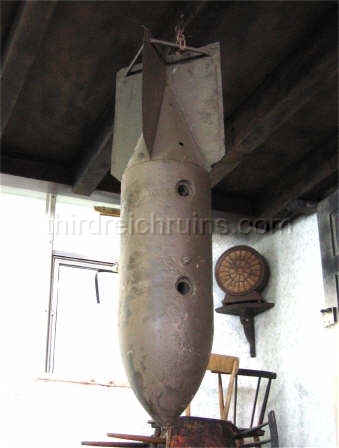
|
 |
|
The
concrete practice bombs used at Sulzheim looked like this before they
were dropped. The concrete was cast around an inner framework of steel
tubing, and metal fins were attached to the back (these tail fins and
steel framework are the twisted rusting objects seen in the bomb photos
above). This original practice bomb is on
display today at the Museum
Stammheim am Main.
|
|

|
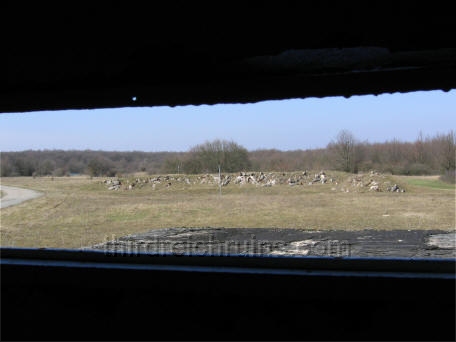
|
|
This
building at the Sulzheim bombing range was apparently a bunker for
observation of the bombing practice (the structure on the right side is
a postwar addition). It has thick reinforced concrete walls with
protected observation slits. On the right is a view from one of these
slits, looking toward a pile of the concrete practice bombs. |
I wish to acknowledge the kind assistance
provided by the staff of the Stadtarchiv Schweinfurt during my photo research
See also the subpage
on the Luftwaffe Munitions Depot at Rottershausen, north of Schweinfurt.
Click here
for a list of suggested readings on the battles for Schweinfurt.
Click
here for a link to a MapQuest map of Schweinfurt.
 Back to the Third Reich in Ruins homepage Back to the Third Reich in Ruins homepage
|
